
You're about to access information on another website.
Just a quick heads up—we're not responsible for verifying or maintaining information outside of this website.
Today's recommended first-line treatments for BV include metronidazole 500 mg taken orally twice a day for 7 days.1 Or, one full applicator of metronidazole gel (5g) 0.75%, applied once a day for 5 days. Or, one full intravaginal applicator clindamycin cream (5g) 2%, applied at bedtime for 7 days.1
But, with more than 4 million women in the United States treated annually for BV, only about 50% adhere to treatment as prescribed; this is attributable to factors like dosing frequency, route of delivery, or cost.2,3
While these treatments may be effective in the short term, adverse side effects are common and include nausea, vomiting, an unpleasant metallic taste in the mouth, and, at times, vaginal candidiasis.4
In a recent qualitative study of patient attitudes surrounding BV care and treatment, a majority of women said they felt frustrated and dissatisfied with current treatment regimens.4 So much so, almost 70% will attempt to self-medicate or treat BV with over-the-counter remedies instead.5 Most of these remedies are ineffective, with some remedies (such as douching) increasing the likelihood of BV.6 Poor adherence to anti-infective therapy can also increase with the length and complexity of the drug regimen.7
60% of women who have BV will likely see it return within 12 months.7 That's why new and innovative approaches are needed to reduce the burdens of existing recommended regimens.
PATIENT PERCEPTIONS OF CURRENT BV REGIMENS

GOOPY AND GROSS MESS
Vaginal gels and creams

METALLIC TASTE,
DIFFICULT TO SWALLOW PILLS
Oral medication

LONG ENOUGH TO CONSIDER
ABANDONING TREATMENT
Length of regimen

HEADACHE, STOMACH PAIN,
DIARRHEA, NAUSEA
Side effects
HEALTHCARE PROVIDER PERCEPTIONS OF CURRENT BV REGIMENS
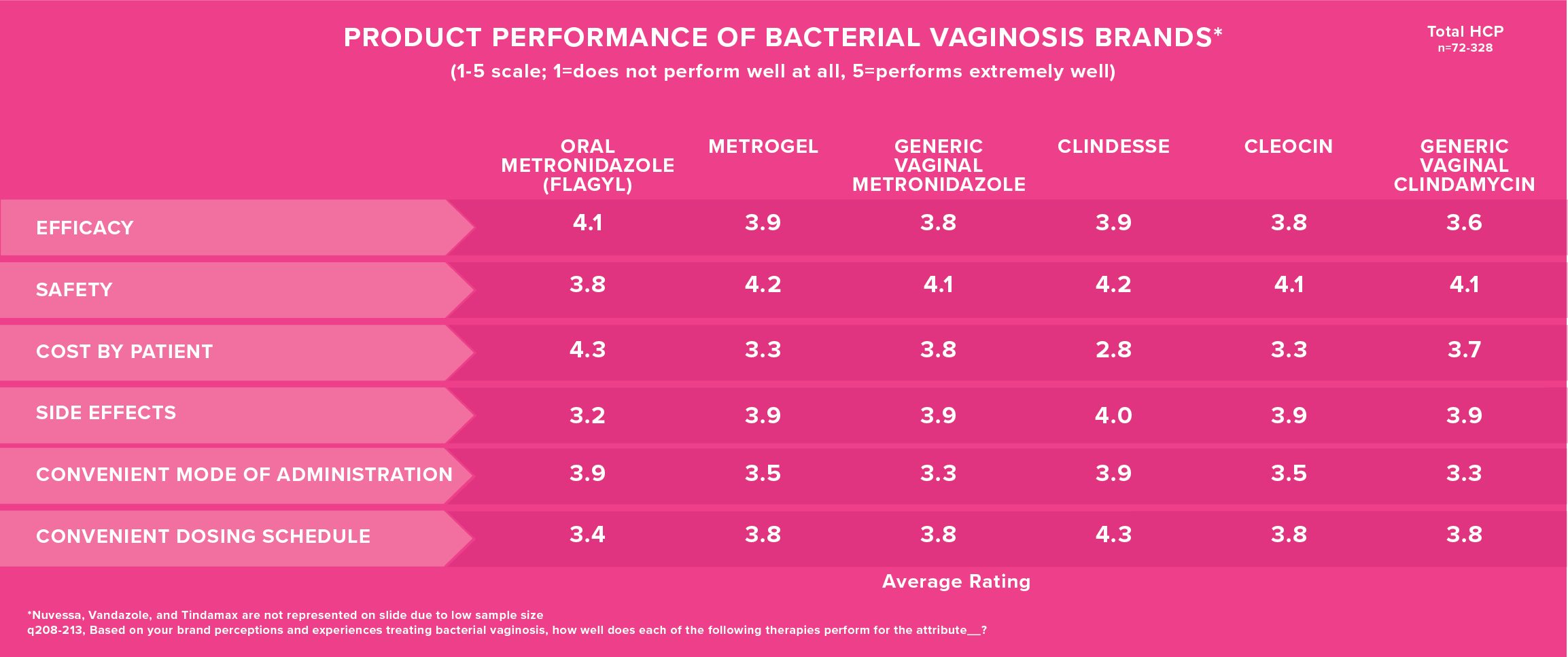
(1-5 scale; 1=does not perform well at all, 5=performs extremely well)
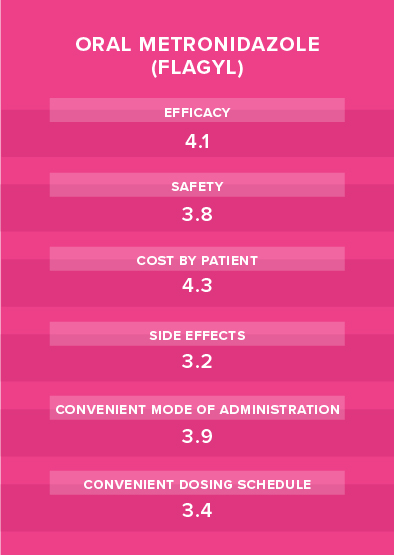
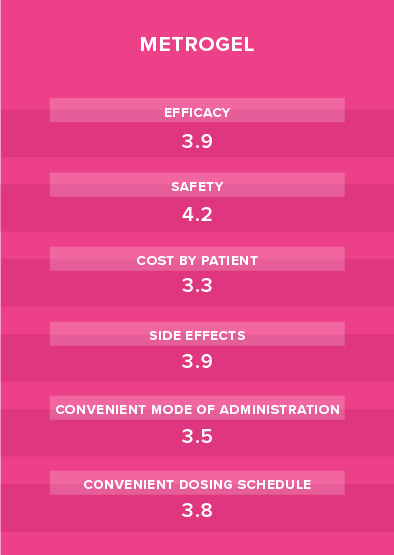
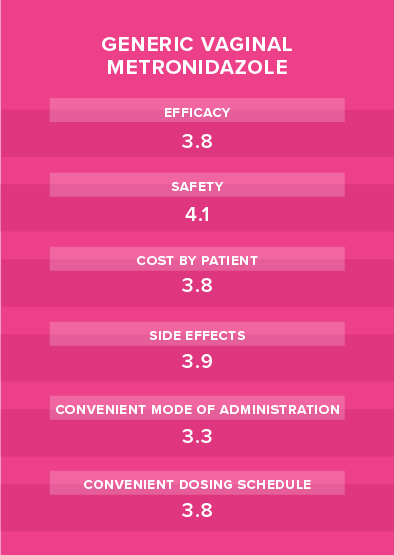
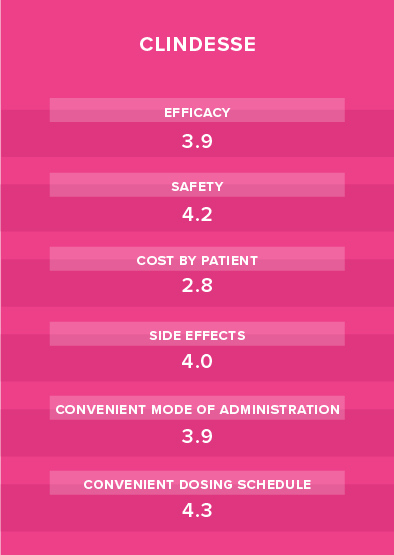
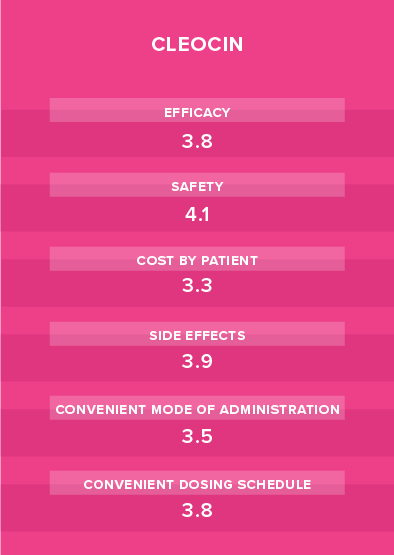
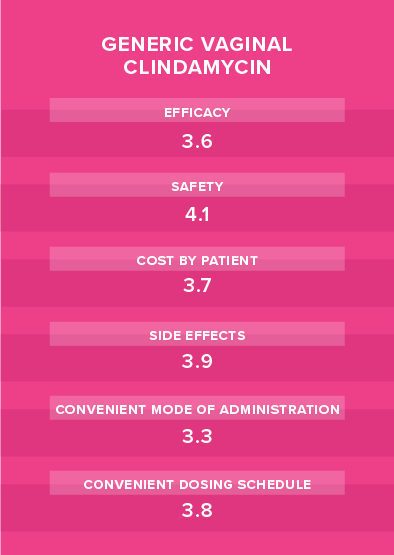
Download the Do's & Don'ts to help guide your patients through treatment. Also, if you'd like to gain deeper insight into how your patient might be feeling, learn about BV's impact on her.
IN HER WORDS
An innovative approach to treating BV need not only apply to medical regimens. In a qualitative study, a majority of women expressed the need for greater public awareness and improved education regarding women's health in general—and BV particularly.4
Of course, education is only the start. Women also expressed the need for treatment and preventive options that do not require taking antibiotics regularly.
Recent developments in the medical industry have unveiled a new, single-dose oral therapy for BV. To learn more about this FDA-approved treatment, visit these links:
Survey conducted online by Harris Poll on behalf of Symbiomix Therapeutics, LLC, a Lupin Company and the American Sexual Health Association (ASHA) within the United States between September 14 and 29, 2017 among 304 US women aged 18-49 who have been diagnosed by a healthcare professional with bacterial vaginosis (BV) within the past 2 years ("women with bacterial vaginosis"). Figures for age, income, race/ethnicity, region, education, and size of household were weighted where necessary to bring them into line with their actual proportions in the population.8
Pledge on Privacy: The term "personal data" as used in this Policy refers to information such as your name, birth date, email address or mailing address that can be used to identify you. Lupin will not process your personal data without your consent. In processing your personal data, we pledge to fully comply with internationally recognized standards of privacy protection. In so doing, we ensure compliance by our staff with strict standards of security and confidentiality. The next sections explain how and when we collect personal data from you.
Intended Use of Personal Data: Most of our services do not require any form of registration, allowing you to visit our site without telling us who you are. However, some services may require registration. When you register with us, you may need to complete certain fields (some are required and some are optional), as well as choose a user name and password. In these situations, if you choose to withhold any personal data requested by us, it may not be possible for you to gain access to certain parts of the site and for us to respond to your query. Lupin processes personal data for specific and limited purposes, which we inform you about when we ask you for information. For example, we may collect and use personal data to provide you with products or services, to bill you for products and services you request, to market products and services that we think may be of interest to you, or to communicate with you for other purposes. Information you send to our customer service department is used only to help resolve your problem and is otherwise kept private. Lupin keeps your data only for as long as is reasonably needed for such purposes and in accordance with any applicable legal or ethical reporting or documentation retention requirements
Non-Disclosure of Information: Lupin will not sell, share, or otherwise distribute your personal data to third parties outside the Lupin group. However, personal data may occasionally be transferred to third parties who act for or on behalf of Lupin, or in connection with the business of Lupin, for further processing in accordance with the purpose(s) for which the data were originally collected. Where disclosure of personal data to a third party is likely or necessary for whatever reason, Lupin will, wherever possible, endeavor to ensure that the disclosure and intended use of the data are clearly indicated. Such third parties may operate different privacy policies. However, we endeavor to ensure that such third parties provide the same level of protection as Lupin and, where appropriate, we will contractually require them to process data transferred only for the purposes expressly authorized by Lupin. We will not share with third parties any data about you that is sensitive (e.g., medical information) in the absence of your prior and explicit consent. Your consent may always be revoked at a later date. If consent is revoked, Lupin may not be able to carry out certain requests made by you. Lupin will, where practicable, inform third parties to whom your data have been transferred of your withdrawal of consent.
Right of Access: You have the right to access and update your personal data or to require their deletion. We endeavor to ensure that personal data are up-to-date, accurate, and complete. If you wish to access or correct your personal data held by us, please contact the Webmaster. Your requests will be dealt with in a prompt and proper manner. No charge will be levied for complying with a correction request, however, for all other requests Lupin may charge a small fee to cover its costs. Requests to delete personal data will be subject to any applicable legal and ethical reporting or document filing or retention obligations imposed on Lupin.
Security and Confidentiality: To ensure the security and confidentiality of personal data that Lupin collects on-line, Lupin uses data networks protected, inter alia, by industry-standard firewall and password protection. Access to personal data is restricted to those employees who have a need to use the data and who have been trained to handle such data properly and observe strict standards of confidentiality. If an employee breaches our policies and procedures, he/she will be disciplined accordingly. Staff compliance with our policies and procedures is regularly audited and reviewed. While we cannot guarantee against any loss, misuse or alteration to data, we try to prevent such unfortunate occurrences.
Data Transfer Abroad: Lupin is a global enterprise and has databases in different jurisdictions. Lupin may transfer your data to one of its databases outside your country of domicile. If the level of privacy protection in a country does not comply with recognized international standards, we will ensure that data transfers to Lupin databases in that country are adequately protected and that the transfer of data to third parties in such countries will not occur unless we obtain your express consent to such transfer in advance.
Anonymous Data and “Cookies”: Most of the information that Lupin collects from its website(s) is anonymous information, such as the pages you visit and searches you perform. When you visit our website, we do not collect any personal data from you unless otherwise authorized by you. Anonymous information is processed by Lupin to help improve the contents of the site and to compile aggregate statistics about individuals using our site for internal, market research purposes. In so doing, Lupin may install "cookies" that collect the first first-level domain name of the user (e.g., "bigmail.com" from an e-mail address of "john@bigmail.com") and the date and time of access. "Cookies" by themselves cannot be used to discover the identity of the user. A "cookie" is a small piece of information, which is sent to your browser and stored on your computer's hard drive. Cookies do not damage your computer. You can set your browser to notify you when you receive a "cookie;" this will enable you to decide if you want to accept it or not.
Spamming: Lupin does not condone "spamming." Spamming is defined as sending unsolicited e-mails, usually of a commercial nature, in large numbers and repeatedly to individuals with whom the sender has had no previous contact or who have declined to receive such communications. In contrast, where Lupin believes that certain product, health, or other information is of importance to you it reserves the right to inform you by e-mail whilst giving you the choice of opting out of such service.
Personal Information and Children: Lupin will not knowingly collect, use or disclose personal data from a minor under the age of 13, without obtaining prior consent from a person with parental responsibility (e.g., a parent or guardian) through direct off-line contact. We will provide the parent with (i) notice of the specific types of personal data being collected from the minor, and (ii) the opportunity to object to any further collection, use, or storage of such information.
Links to Other Sites: This Privacy Policy applies only to Lupin websites to the exclusion of third party websites. Lupin may provide links to other websites, which we believe, may be of interest to our visitors. We aim to ensure that such websites are of the highest standard. However, due to the nature of the World Wide Web, Lupin cannot guarantee the standards of every website link it provides or be responsible for the contents of non-Lupin sites.
Contact Lupin: If you have any queries or complaints about our compliance with this Privacy Policy, or if you would like to make any recommendations or comments to improve the quality of our Privacy Policy, please contact the Webmaster. This privacy policy is effective as of October 15, 2003. We aim to constantly improve the tools available to you to manage the data that you provide to us. Please refer to this page from time to time to review these and other new features.
Legal Disclaimer: The information provided on this site is provided for educational purposes and with no guarantee as to its accuracy. Do not use this site as a substitute for medical care or medical advice. Lupin is not engaged in the practice of rendering medical advice, and nothing on this site should be construed as recommending any pharmaceutical product for a particular use. In the case that you have any medical questions or issues, please consult with your physician or other medical care provider.
In no event shall Lupin be liable for any special, direct, indirect, consequential, or incidental damages or any damages whatsoever, whether in an action of contract, negligence or other tort, arising out of or in connection with the use of this Website or the Information. Lupin reserves the right to make additions, deletions, or modifications to the Information on the Website at any time without prior notice.
No license or right, express or implied, is granted to any person under any patent, trademark, trade dress or other proprietary right as a result of use of this website.
INFORMATION ON THIS WEBSITE IS PROVIDED "AS IS" WITHOUT WARRANTY OF ANY KIND, EITHER EXPRESS OR IMPLIED, INCLUDING, BUT NOT LIMITED TO, THE IMPLIED WARRANTIES OF MERCHANTABILITY, FITNESS FOR A PARTICULAR PURPOSE, OR NON-INFRINGEMENT.
The Securities and Exchange Commission (SEC) encourages companies to disclose forward looking information so that investors can better understand a company's future prospects and make informed investment decisions. Due to changing market conditions, product competition, the nature of product development, and regulatory approval processes, the achievement of forward looking statements contained in this Website are subject to risks and uncertainties. For a fuller discussion of any issues relating to Lupin or its corporate affiliates, please see either the Lupin Pharmaceuticals or Lupin Limited websites. A link from this Website to a non-Lupin Website does not constitute an endorsement of the products or services offered by that or any other non-Lupin Website.
Please carefully read these Terms of Use and our Privacy Policy before using our Website. By using the Lupin Website, you agree to follow and be bound by these Terms of Use and our Privacy Policy without modification. In the case of any violation of these Terms of Use, Lupin reserves the right to seek all remedies available at law and in equity for such violation. Because we will continue to implement new technologies and improve the services and features we provide on our Website, this statement is subject to change without prior notice. For that reason, we encourage you to review this statement periodically. By using our Website, you agree to the Terms of Use in effect at that time.
Use of Website: Lupin Website may contain other proprietary notices and copyright information, the terms of which must be observed and followed. Information on this Website may contain technical inaccuracies or typographical errors. Information may be changed or updated without notice. Lupin reserves the right to refuse service in its discretion, including, without limitation, if Lupin believes that customer conduct violates applicable law or is harmful to the interests of Lupin.
Submitted Information: No information or material provided to Lupin by you through our Website may contain vulgar, obscene, threatening or otherwise unlawful language or material. Lupin will not release your name or otherwise publicize the fact that you submitted materials or other information to us unless we obtain your permission to use your name or we are required to do so by law. Please review our Privacy Policy for a complete description of how we handle personal information submitted to us.
Lupin Information: Lupin has made a conscious effort to display and describe information about Lupin on the site accurately so that you can get a good idea of our business. Furthermore, Lupin is constantly improving its information. The materials on this Website are for your general educational information only. Lupin does not practice medicine or provide medical services or advice, and the information on this Website should not be considered medical advice. You should always rely on your health care professional for diagnosis and treatment.
Trademarks: Lupin's names and logos referenced on the Website are trademarks of Lupin in India and other countries and may not be used in connection with any product or service in any manner that is likely to cause confusion among customers or in any manner that disparages or discredits Lupin.
All other trademarks not owned by Lupin that appear on this Website are the property of their respective owners, who may or may not be affiliated with, connected to, or sponsored by Lupin.
If you use the materials or trademarks on this Website in a way that is not clearly allowed by these Terms of Use, you are violating your agreement with us and may be violating copyright, trademark, and other laws. In that case, we automatically revoke your permission to use this Website. Title to the materials remains with us or with the authors of the materials contained on this Website. All rights not expressly granted are reserved.
Change to Term of Use: Lupin reserves the right to update the Terms of Use statement at any time. Any changes or updates will be effective immediately upon posting to this Website. Your use of this Website constitutes acceptance of our Terms of Use. If you do not agree to the terms, please exit from this Website immediately.